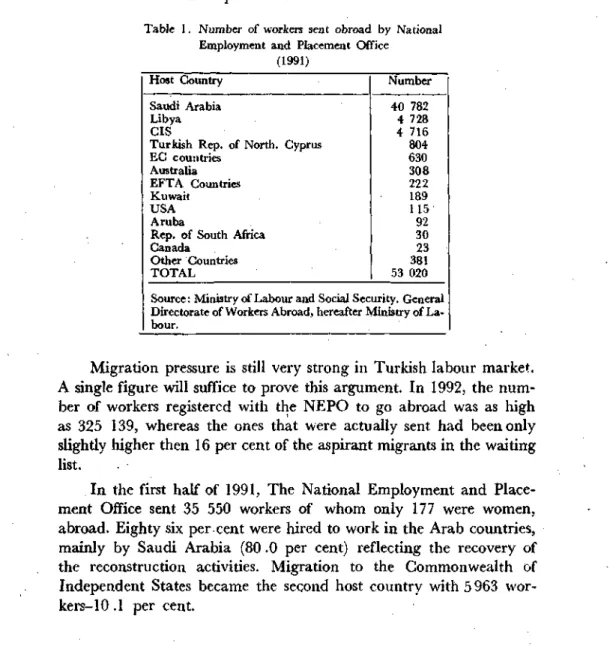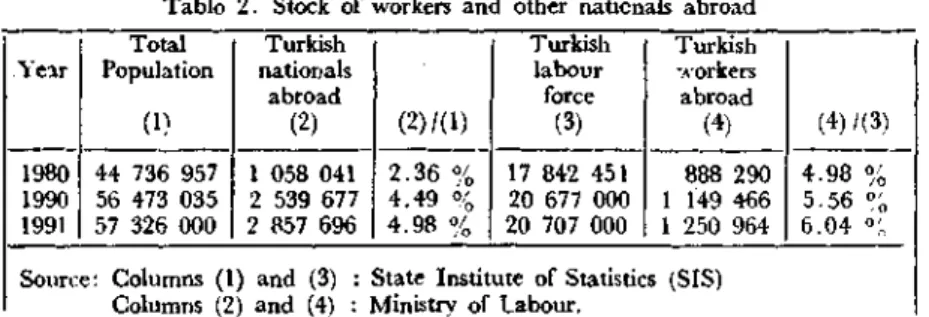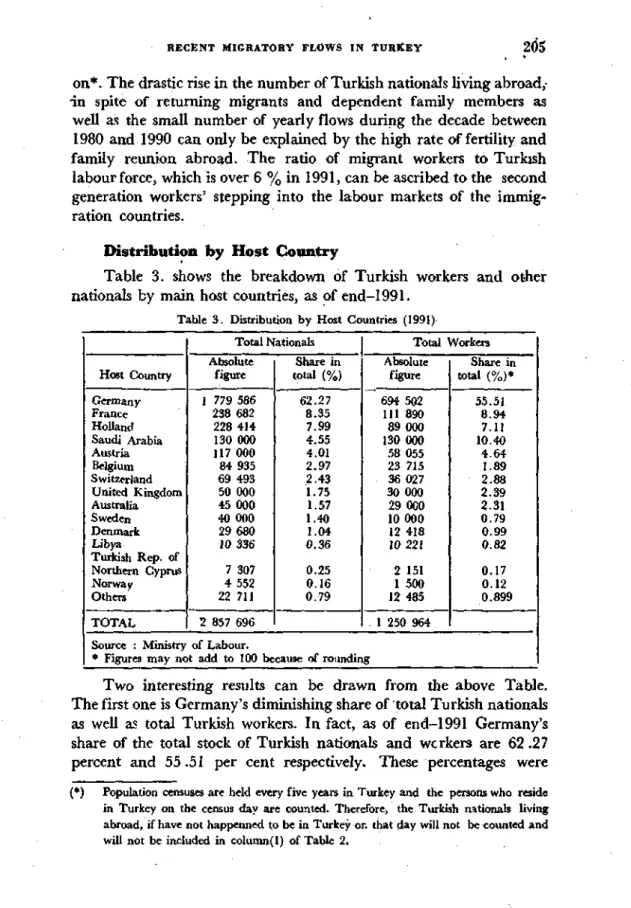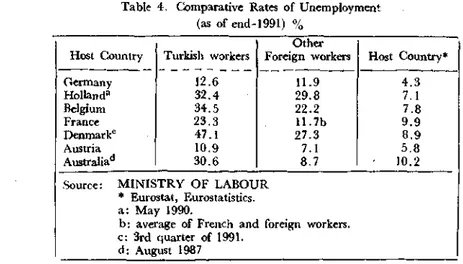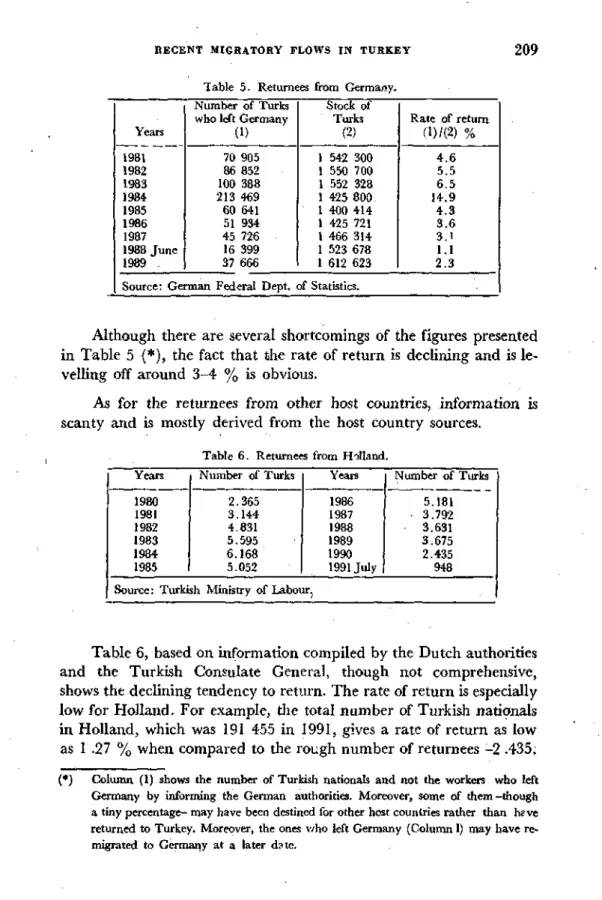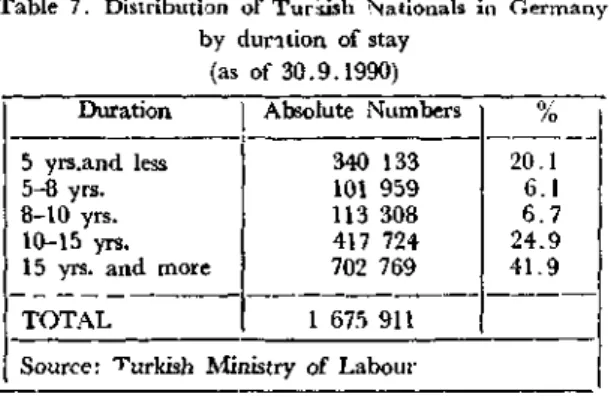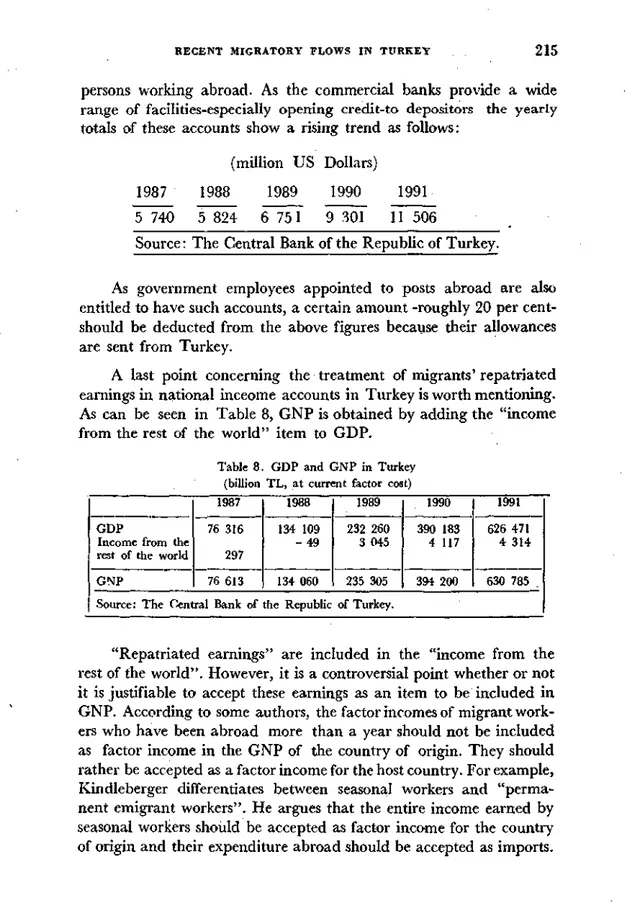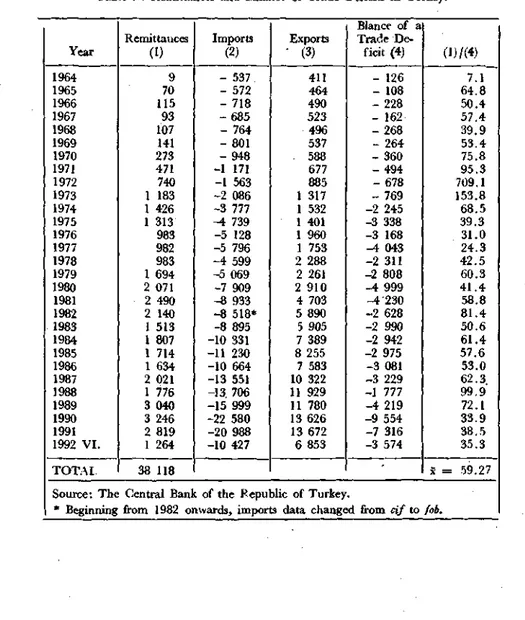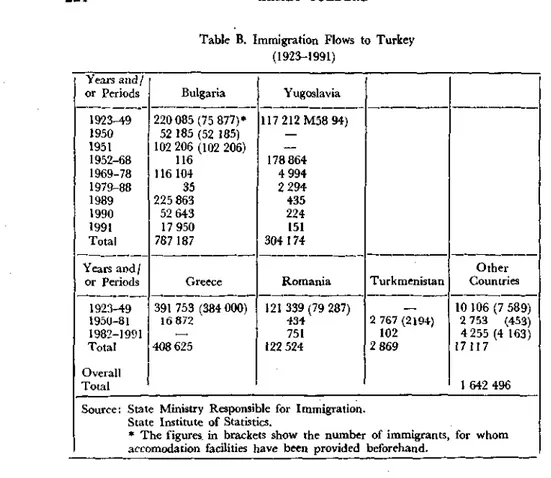RECENT MIGRATORY FLO*WS İN TURKEY* Prof. Dr. Ahmet GÖKDERE Introduction
The period under review, mainly 1991 and the first half of 1992, was a period of economic instability. The growth rate in 1991, vvhich was 9 .7 per cent in 1990, declined to 0.3 per cent, due to the unfa-vourable effects of the Gulf crisis and the election economics of 1991 on production, investments and prices. in 1991, the Turkish econ-omy dİd not grow but contracted. The decline in the grovvth rate was mainly due to the decline in agricultural production vvhich amounted to 9 .1 per cent in the last quarter of the year, though the rates realized by industrial and manufacturing industry production were also lower with respect to the previous year. Negative effects of public finance deficits coupled vvith high rates of interest and the volume
of money supply helped accelerate the rate of inflation.
As a result of the relative slovving dovvn in economic activitiy and the rising foreign exchange rates, imports declined and exports increased and consequently the nominal foreign trade deficit declined. Despite the decline in the revenues of tourism and the vvorkers' remit-tanceSj the contraction of the fcreign trade deficit together vvith other credit items in the current accounts, the balance of current accounts had a small surplus of 272 milJion Dollars-compared to -2 6235 in
1990.
in 1991, the Turkish Lira depreciated in both nominal and real terms. The external debts did not show an important development and equalled 43 2 10 million Dollars as of end-1991.
GNP increased in real terms in the first and the second quarters of 1992 by 6.7 per cent and 6.1 per cent respectively. The rate of inflation slovved dovra slightly in the first half of 1992. in the same
(*) This paper is subttıitted to the Annual Meeting of correspondehts of Gontinuous Reporting system on Migration (SOPEMl)-OECD in Paris, during 25-27 No-vember 1992.
period, hovvever, workers' remittances declined, and the deficit of foreign trade and the deficit of current accounts both increased.
As for the external migration within the period under considera-tion, mainly ovving to the recent turmoil in the former USSR and in some of the East European countries as well as the Gulf crisis, Turkey, the traditional country of emigration of 1960s, turnerd out to be a country of temporary settlement a n d / o r iriımigration. The exodus of thousands of ethnic Turks form Bulgaria and to a lesser extent from the former Yugoslavia, who are in search of a safe haven has been a great concern for the Turkish government.
Migration to Western Europe, on the other hand, has stagnated since the first Oil Shock of 1973 and flows to the Arabic countries havc been badly affected by the Gulf crisis. Therefore, migratory movc-ments in Turkey should be treated in that context, accepting Turkey as a country of emigration and a country of immigratioıı, though the foımer has produced more profound and far-rcaching cffects on the socio-economical strueture of Turkey.
F l o w s
Being Middlc-East bound and project-tied havc been the most salient features of recent Turkish migration. i n fact, out of a total of 5 3 020 Turkish vvorkers sent abroad by the National Employment and Placement Office (NEPO) in 1991, 11 252 vvere hircd by Turkish firms contraeting abroad and the rest, i.e. 41 769 by foreign firms. The main hoşt countries werc Saudi Arabia (76.3 %) and Com-monvvealth of Independent States (CIS) (8.8 % ) . Only 630 workers vvere sent to EC countries of which only 49 vvere bound for Germany i n spite of the unfavourable effccts of the Gulf crisis oa migration, total number of vvorkers sent abroad was 11 .1 per cent higher than the previous year-vvhich vvas 47 707. CIS, presently the third main hoşt country might become a promising outlet for Turkish vvorkers in the near future, if the objeetives of the Summit Declaration on Black Sea Economic Cooperation, signed by 11 contries - 6 out of vvhich CIS countries- on 25 J u n e 1992, can be achieved.
The 1991 migratory flovvs ha ve also been dominated by male vvorkers, vvho are mainly employed in construction vvork. Therefore, only 301 female vvorkers could join the 1991 flevvs. The 1ow female participation rate prevailing in non-secular Arabic countries is another
RECENT MIGRATÖRY FLOWS İN TURKEY 2 0 3
reason accounting for the poor representation of female migrant workers vvithin the mîgratory flows.
it should also be noted that, recent Turkish migrant workers are mostly hired by contracting firms engaged in infrastructural investments abroad, which are not per se, self-perpetuating and should not be regarded creating new job slots. Therefore, especially the Arabic countries should not be regarded as a growing potential maıket for Turkish surplus labour.
Table 1. Nuraber of workers sent obroad by National Employment and Placeraent Office
(1991) Hoşt Country
Saudi Arabia Libya CIS
Turkish Rep. of North. Cyprus EG countries Australia EFTA Countries Kuwait USA Aruba
Rep. of South Africa Canada Other Countries TOTAL Number 40 782 4 728 4 716 804 630 308 222 189 115 • 92 30 23 381 53 020 Source: Ministry of Labour and Social Security. General Directorate of YVorkers Abroad, hereafter Ministry of La bour.
Migration pressure is stili very strong in Turkish labour market. A single figüre will suffice to prove this argument. in 1992, the num ber of workers registercd vvith the NEPO to go abroad was as high as 325 139, vvhereas the ones that were actually sent had beenonly slightly higher then 16 per cent of the aspirant migrants in the waiting list.
in the first half of 1991, The National Employment and Place-ment Office sent 35 550 workers of whom only 177 were women, abroad. Eighty six per cent were hired to work in the Arab countries, mainly by Saudi Arabia (80 .0 per cent) reflecting the recovery of the reconstruction activities. Migration to the Commonwealth of Independent States became the seçond hoşt country with 5 963 wor-kers-10 .1 per cent.
Ali the migrants have founçl the jobs on their own initiative and 68
per cent of them are qualified and highly qualified wcrkers, including more than 300 engineers. The level of education, on the other hand, is rather low. Seventy four per cent of the whole group is only primary school graduates.
There is a remarkable increase in the number of the aspirant migrants in the waiting list of the Office. As of J u n e 1992, fhe accu-mulating number of applicants is 924 787, of which, 24 230 are females. 703 543 or 76 per cent of the total are qualified vvorkers, reflecting the severe unemployment prevailing in Turkey.
Stocks o f T u r k i s h W o r k e r s a n d N a t i o n a l s Abroad
The total accumulated stock of Turkish migrant workers and dependent family members is important on various grounds and to the extent that the number of yearly flows diminishes, the significance of the amount of Turkish vvorkers and nationals living abroad increases. The data on this stock is hovvever, highly scanty and is not compre-hensive as it does not cover the clandestine workers-except those, vvhose situation was legalized later on. The figures shovvn in Table 2 Column (2) and (4) have been compiled from the reports of Turkish Labour Attach^s in 14 countries. As of end-1991, 2 857 696 Turkish nationals have valid residence permits. If those, outside the consular district of the 14 Attach^s together vvith the illegal vvorkers, asylum seekers and refugees are taken into consideration, the total exceeds 3 million.
Tablo 2. Stock of vvorkers and other nationals abroad Year 1980 1990 1991 Total Population (1) 44 736 957 56 473 035 57 326 000 Turkish nationals abroad (2) 1 058 041 2 539 677 2 857 696 (2)/(l) 2.36 % 4.49 % 4.98 % Turkish labour force (3) 17 842 451 20 677 000 20 707 000 Turkish •A'orkers abroad (4) 888 290 1 149 466 1 250 964 (4) /(3) 4.98 % 5.56 % 6.04 °;. Source: Columns (1) and (3) : State Institute of Statistics (SIS)
Columns (2) and (4) : Ministry of Labour.
Table 2 reflects the significance of migration from a demographic point of view on the one hand, and from the Turkish labour market aspect on the other. As of 1991, the number of Turkish national living abroad is equal to nearly 5 % of Turkey's resident or de facto
RECENT MIGRATORY FLOWS İN TURKEY 2 0 5
on*. The drastic rise in the number of Turkish nationals living abroad,-•in spite of returning migrants and dependent family members as
well as the small number of yearly flows during the decade betvveen 1980 and 1990 can only be explained by the high rate of fertility and family reunion abroad. The ratio of migrant vvorkers to Turkish labour force, which is över 6 % in 1991, can be ascribed to the second generation workers' stepping into the labour markets of the immig-ration countries.
Distribution by Hoşt Country
Table 3. shovvs the breakdovvn of Turkish vvorkers and other nationals by main hoşt countries, as of end-1991.
Table 3 . Distribution by Hoşt Countries (1991)
Hoşt Country Germany France Holland Saudi Arabia Austria Belgium Svvitzerland United Kingdom Australia Svveden Denmark Libya Turkish Rep. of Northern Cyprus Norvvay Others TOTAL Total Nationals Absolute figüre 1 779 586 238 682 228 414 130 000 117 000 84 935 69 493 50 000 45 000 40 000 29 680 10 336 7 307 4 552 22 711 2 857 696 Share in total (%) 62.27 8.35 7.99 4.55 4.01 2.97 2.43 1.75 1.57 1.40 1.04 0.36 0.25 0.16 0.79 Total VVorkers Absolute figüre 694 502 111 890 89 000 130 000 58 055 23 715 36 027 30 000 29 000 10 000 12 418 10 221 2 151 1 500 12 485 1 250 964 Share in total (%)* 55.51 8.94 7.11 10.40 4.64 1.89 2.88 2.39 2.31 0.79 0.99 0.82 0.17 0.12 0.899
Source : Ministry of Labour.
* Figures may not add to 100 because of rounding
Two interesting results can be dravvn from the above Table. The first one is Germany's diminishing share of total Turkish nationals as well as total Turkish workers. in fact, as of end-1991 Germany's share of the total stock of Turkish nationals and wcrkers are 62 .27 percent and 55.51 per cent respectively. These percentages vvere
(*) Population censuses are held every five years in Turkey and the persons who reşide in Turkey on the census dav are counted. Therefore, the Turkish nationals living abroad, if have not happenned to be in Turkey on that day will not be counted and vvill not be included in column(l) of Table 2.
72 .4 and 66 .5 in 1980 and had even been higher in 1960s and 1970s. The second result is the stability of dependeney ratio över the decade betvveen 1980 and 1991. i n 1980, the dependeney ratio, i.e. total nationals divided by total workers, was 2 .27(*). As can be calculated from Table 3(2 857 696/ 1 250 964) the ratio hasn't changed: 2 .28. This ratio shows that, the efforts tovvards family reunion abroad haven't been successful, as an average migrant family, ineluding the vvorker, consists of only 2 .28 members. Even if the distorting effect of the Arab contries, where male migrants dominate, is elimina-ted the situation doesn't improve much, as the ratio rises slightly-2 .45. For Germany, however, we have somewhat higher ratio and a modest improvement between 1980 and 1991-from 2 .47 to 2 .56.
U n e m p l o y m e n t Abroad
The unemployment rate is rather high among Turkish vvorkers in European countries and in Austrialia as can be observed from Table 4. i n fact, it is higher than the average rate of unemployment for foreign workers as a vvhole, vvhich is also considerably higher than
the rate for native workers of each hoşt country.
Table 4. Comparative Rates of Unemployment (as of end-1991) % Hoşt Country Germany Holland3 Belgium France Denmark0 Austria Australiad Turkish vvorkers 12.6 32.4 34.5 23.3 47.1 10.9 30.6 Other Foreign vvorkers 11.9 29.8 22.2 11.7b 27.3 7.1 8.7 Source: MINISTRY OF LABOUR
* Eurostat, FiUrostatistics. a: May 1990.
b : average of French and foreign vvorkers. c: 3rd quarter of 1991. d: August 1987 Hoşt Country* 4 . 3 7.1 7.8 9.9 8.9 5.8 • 10.2
There are reasons to speculate that the above rates of unemp loyment for Turkish vvorkers might have in effect been higher. To the extent that there is diguised unemployment or underemployment
(*) 1980 figures are based on Philip I., Martin, An assessment of Turkish Labor Mig-ration to Westem Europe, Working Paper, ILO.p. 24-25, Table 2 . 2 .
R E C E N T MIGRATORY FLOVVS Î N T U R K E Y 207
among the self-employed Turkish vvorkers, they can per se not be included into Table 4, the above rates should be higher. Another reason is the existence of the so-called tourist-ıvorkers or clandestine employment, vvhich represents a highly precarious type of unem-ployment.
Several reasons might account for these high rates. Firstly, Turkish vvorkers are not very keen on learning foreign languages and on at-tending vocational training courses. Therefore, sorne of them-especially those of the second generation-lack the necessary skills required by today's automation and high technology. Secondly vvorkers vvho run a family business at the same time vvill notbeenthusiasticenoughtofind a job as long as they are entitled to receive unemployment allovvance atfirst, then social aid in the case of Germany. i t is hard tojudge the extent of discrimination against foreign vvorkers and especially tovvarcls those vvho are Turkish, under recessionary conditions.
i n this regard, the follovving figures, shovving the employment situation of Turkish vvorkers in Holland, in 1990 are quite remarkable.
Employed workers
Unemployment allovvance recipients Social allovvance recipients TOTAL Number ofrtrorkers 36 000 28 818 24 188 89 006 Source : Ministry of Labour
i n the case of the Arab, countries and Libya, unemployment among Turkish vvorkers is practically non-existent. As the vvorkers are project-tied, vvhen t;he project is completed or if the firms that hired the vvorkers are closed or vvent bankrupt, the vvorkers return home.
The official estimate of the total number of unemployed Turkish vvorkers abroad is över 156 000 in 1991.
Enterpristing T u r k s abroad
A tendency tmerging during the early 1980s among the econom-ically active population in hoşt countries, was to öpen one's own business and to become an independent vvorker. The existence of brisk demand for some Turkish goods and services, of the Turkish community established abroad, attracted the nevvly emerging Turkish
businessmen. Most of the firms are small scale, though there are a few medium to large scale ones such as transportation firms.
Existing data concerning enterprising Turks, mostly gathered from Turkish associations of artisans and employers and from the La-bour Attachds in the hoşt countries are not exhaustive. On the other hand, they refer to the number of self-employed vvorkers in some ins-tances and to the number of firms in the others.
in Holland, there were 1 121 firms opened by Turks in 1991. Within this total one - man businesses were in the majority; though
there vvere partnerships and even corporations.
in Belgium, 1 367 Turkish nationals were given "self-employ-ment cards" in 1991. Retail and wholesale trade (728), catering busi-ess (248) were the leading coccupations.
Overall figures are not available for France. However, the Con-sulate General in Lyon reported by the firms in its consular district in
1991 that there had been some 400 self-employed Turks vithin the district of the Consulate General in Marseilles. "The Union of Turkish Employers in France " had 119 members, who ran business in Paris region.
The estimated number of firms in Denmark has risen from 400 in 1990 to 500 in 1991. These are mostly small scale with limited ca-pital and applying labour-interısive methods of production. The proliferation of such firms, mostly in catering business, is partly due to the rise in the number of unemployed Turkish vvorkers as vvell as the encouraging policy of the Danish Government.
No data is available in the reports of the Turkish Ministry of Labour as to the case in Germany.
Returned Migrants
Ovving to the lack of adequate statistical data on the subject, there is no agreement as to the number of Turkish migrants vvho have returned home. Therefore, one must rely on the statistical information compiled by some cf the hoşt countries.
Table 5, in vvhich the figures of Germany's Federal Department of Statistics are used, is arranged, in order to have a rough idea about the tendency to return and the rate of return, during the recent years.
RECENT MIGRATORY FLOWS İN TURKEY 2 0 9
Table 5. Returnees from Germany. Number of Turks
vvho left Germany (1) 70 905 86 852 100 388 213 469 60 641 51 934 45 726 16 399 37 666 Stock of Turks (2) 1 542 300 1 550 700 1 552 328 1 425 800. 1 400 414 1 425 721 1 466 314 1 523 678 1 612 623 Rate of return (l)/(2) % 4 . 6 5.5 6.5 14.9 4 . 3 3.6 3.1 1.1 2 . 3 Source: German Federal Dept. of Statistics.
Although there are several shortcomings of the figures presented in Table 5 (*), the fact that the rate of return is declining and is le-velling off around 3-4 % is obvious.
As for the returnees from other hoşt countries, information is scanty and is mostly derived from the hoşt country sources.
Table 6. Returnees from Holland. Years 1980 1981 1982 1983 1984 1985 Number of Turks 2.365 3.144 4.831 5.595 6.168 5.052 Source: Turkish Ministry of Laboı
Years 1986 1987 1988 1989 1990 1991 July ir. Number of Turks 5.181 3.792 3.631 3.675 2.435 948
Table 6, based on information compiled by the Dutch authorities and the Turkish Consulate General, though not comprehensive, shovvs the declining tendency to return. The rate of return is especially low for Holland. For example, the total number of Turkish nationals in Holland, which was 191 455 in 1991, gives a rate of return as low as 1 .27 % vvhen compared to the rough number of returnees -2 .435.
(*) Column (1) shovvs the number of Turkish nationab and not the vvorkers vvho left Germany by informing the German authorities. Moreover, some of them-though a tiny percentage- may have been destined for other hoşt countries rather than hfve returned to Turkey. Moreover, the ones \vho left Germany (Column 1) may have re-migrated to Germany at a la ter d?te.
Years 1981 1982 1983 1984 1985 1986 1987 1988 J u n e 1989
The Return Act, which temporarily came into force on 15 No-vember 1985, did not encourage returns, as envisaged. i n fact, only 2 643 Turks (12 94 families) in. 1989 and 675 Turks (383 families) in 1990 returned home, vvithin the framework of the Act. T h e inade-quacy of 930 Guilders as the monthly allowance and cancellation of the residence permit and health insurance were found to be the dis-couraging provisions of the Act.
i t seems that Turkish workers have already outstayed their wel-come, and a great majority of them intend to go on staying. T h e mem-bers of the first generation have already repatriated. The second generation migrants, on the other hand, postpone their final return to unkncwn future dates. Table 7 is arranged in order to give an idea on the length of stay in Germany.
Table 7. Distribution of Tursish Nationals in Germany by d u n t i o n of stay
(as of 30.9.1990) Duration | Absolute Numbers 5 yrs.and less
5-8 yrs. 8-10 yrs. 10-15 yrs. 15 yrs. and more T O T A L 340 133 101 959 113 308 417 724 702 769 1 675 911 /o 20.1 6.1 6 . 7 24.9 41.9
Source: Turkish Ministry of Labour
N a t u r a l i s a t i o n s
Information on the numbers of Turkish migrants who have ac-quired the nationality of the hoşt countries is incomplete and sporad-ic. However, the information compiled from the figures supplied by the Turkish Consulates is as follows:
Germany Holland Belgium France 1990 : 2 016 1989 : 3 277 1990 1990 : 217 1952
Overall figures are not available. There vvere 102 and 101 applications to the Turkish Consulate in Strazburg in 1990 and 1991 and 50 applications to the Consulate General in Marseilles in 1991.
iptHWl|H|«l»lf<!N.-RECENT MIGRATORY PLOWS İN TUKKEY 2 1 1
Denmark : 1991 : 126
Austria : 1990 : 1022 1991 : 2068
Judging by the above figures, it can be argued that naturalisation is not a vvidespread exercise among Turkish migrants in Europe, though the sheer number of those who have actually acquired the na-tionality of the country in which they have been working does not re-flect the size of the potential. it can be speculated that, in most of the
cases, the qualifications of some applicants do not come up with to the required conditions such as profession, proficiency in language, having a decent house and duration of stay. i n fact, naturalisation is more vvidespread among professionals, 'who comply vvith these requix~ements.
Workers' R e m i t t a n c e s
The most salient feature concerning migrant vvorkers' remittanc es is that, they tend to decline during the recent years, in absolute terms as well as in relation to other credit items in the balance-of-payments.
(Million US Dollars)
1989 1990 1991 1992 V I . "3Ö4Ö 3 246 2 829 1 264
The absolute decline, beginning from 1990 onwards is shovvn above. Several reasons account for this unfavourable development:
— Increasing tendency to invest abroad, especially in small-scale family business (a more recent drift to invest in the former East Germany is gaining momentum).
Commensurate vvith the length of time spent abroad is the mar-ked increase in the propensity to consume, resulting from;
— favourable developments in family reunion abroad;
— the Gulf crisis, as a temporary reason, responsible for the dec line in 1991.
- As for the relative decline of remittances in relation to the other items of the balance-of-payments, the drastic rise of Turkish imports and exports and the resulting increase in "the Degree of Openness" (DgO) of Turkish economy, especially after the famous 24 J a n u a r y 1980 Decisions vvhich introduced the requirements of a liberal mar ket economy, should be stressed. DgO, formulated as X + M / G N P ,
which was 7 .96 per cent in 1970, rose to 15 .6 in 1980 and to 23 .7 in 1990.
i n the period of 1980-1991, exports increased by 4 .7 times and imports more than 2 .7 times, whereas the increase in remmittances was only 1 .36 times. i n other vvords, remmittances could not kcep pace either with exports or imports (*). Therefore, Remittances (R) / X ratio, showing the import financingfunction of remittances, exhib-ited a declining trend in the period under con.°ideration. i n fact, the R / X and R / M ratios, which were 71 .0 per cent and 26.1 per cent in 1980 respectively, fell to 20 .6 per cent and to 13 .4 per cent in 1991.
As a corollary of this unfavourable development, compared to the average of 59 .3 per cent for the whole of the period 1964-1992 VJ., the ratio of tlıc remittances to the balan.ee -of-paymeats deficits also declined to the range of 30-35 per cent during recent ycars.
The relative importance of remittances vvithin the credit items of the current accounts also diminished. i n addition to the unpreceden-ted increase of X and M already mentioned, the emergence of new credit items such as Turkish contractors' income transfers from ab-road and the f lourishing > tourism industry accounted for this deve lopment.
i t miglıt be of interest to note that, the total amount of remittan ces, recorded as unilateral credit item in the balance-of-payments since 1964 have amounted to only $ 38 .1 billion, which is more than $ 10 billion less than Turkey's present total of external debts.
The underestimation of workers' remittances can be understood if remittance per worker is taken into consideration. Ycarly remittance per vvorker can be calculated by dividing yearly remittances by the stock of vvorkers of the corresponding year. The related figures for
1990 and 1991 are $ 2 824 and $ 2 253, respectively. i n view of the saving potential of migrant vvorkers, these sums are very modest. i n order to have a better idea as to the size of the part of migrants' savings channelled to Turkey in cash, the term remmittances should be elarified. Remmittances consist of the sums remitted to Turkey through banks or by post and only a small fraction of foreign exchange that is brought to Turkey by the vvorkers. If foreign currencies vvere
(*) Calculations are based on the data in the annexed Table A.
R E C E N T MIGRATORY FLOVVS İ N T U R K E Y 2 1 3
exchanged at the bânks and if it was noted on the receipt that they had originated from migrant workers, the related sums could be included into workers' remmittances, as the receipts are sent to the Central Bank. Hovvever, it is not common to change foreign currencies at the banks, as it is time consuming and the rate is slightly lovver than the rates of the recently mushrooming exchange bureaux and/or goldsmiths and other shopkeepers acting as de i'acto exchange bureaux, as well as re-latives or friends. Therefore, the proportion of foreign currencies chan-ged by private dealers and non-m'igrant nationals, cannot be identi-fied and recorded as vvorkers' remittances.
Migrant vvorkers carry out numerous currency transactions other than their remittances. i t is a common practice to pay in foreign currencies in exchange for some assets, such as real estate and plot of lands in Turkey as vvell as to pay rents and other monetary obligations. A more recent possibility is shopping at Turkish bonded vvarehouses vvhere they can import consumer durables by foreign currencies. Mi grant vvorkers and their close relatives are entitled to import a limited amount of goods each year and upon their final return. They are gi-ven special permits that give them the right to buy duty free goods. Although it is possible for the migrants to buy the same goods abroad and pass them through the customs vvithout paying duties, it is easier tö buy them in Turkey. These transactions, apparently amounting to considerable sums of foreign currency, are not recorded and compiled and are not included in the balance-of-payments. Hovvever, it is not possible to identify the real buyer, as the permits can be sold to shop keepers and to persons vvilling to buy such goods.
A last but not least outlet for their foreign currencies is the stock deposited vvith commercial banks or hoarded especially by the elderly relatives of the migrants. Mostly demanded on precautionary mo-tives, this stock, mainly consisting of cash gifts given by the vvorkers to their close relatives during their visitto Turkey, cannot per se be in cluded in the remittances. Even if these sums are deposited vvith the banks and not hoarded, it is not possible to identify them, as ali Turkish nationals are allovved to öpen foreign exchange deposit accounts vvith the banks.
As for the foreign exchange deposit accounts opened by the the vvorkers themselves, there are tvvo possibilities: a foreign exchange deposit account vvith the Turkish Central Bank or vvith one of the 22 commercial banks having European branches.
D e p o s i t Accounts vvith t h e Central Bank*
i n accordance with the provisions of the agreement concluded with Dresdner Bank A.G. in 1976, it is possible to deposit or withdraw foreign exchange, through the branch offices of the said Bank or the Turkish Central Bank and to deposit money through other banks in Turkey or abroad as well as through post offices. Persons, bearing Turkish passports, who have the residence or work permit and who haven't finally returned to Turkey are entitled to öpen 'foreign-exc-hange deposit account' with the Central Bank. The recent deve-lopment of these accounts, called in short 'the Dresdner Bank Scheme', is as follovvs: (**)
(million US Dollars)
198 7 1988 1989 1990 1991 (*) 5 913 6 208 7 017 7 541 6 439 Source: The Central of the Republic of Turkey
The yearly sums shown above do not represent yearly flows, but the accumulated amount of workers' deposits. Moreover, unlike work-ers' remmittances, they cannot be regarded as final foreign-exchange flows to Turkey, as they can be withdrawn by the depositors abroad at any time. Stili they show the savings potential of the migrant work-ers abroad.
D e p o s i t Accounts vvith t h e C o m m e r c i a l Banks
i n addition to the Central Bank, some 22 Turkish commercial banks with European branch offices are authorized to öpen foreign-exchange deposit accounts for migrant workers and self-employed
(*) The offici?l name of these accounts is foreign exchange deposit account vvith
credit letter. Before foreign exchange control was abolished in Turkey in 1980
these accounts used to provide some srvices for the depositors, including import vvith waiver.
(**) A similar agreement is concluded vvith Algemene Bank Nederland N. V.-Amsterdam Rotterdam Bank N.V. as the system was found attractive on grounds of higher in-terest rates compared to other European banks, and of state guarantee. As a measure of convenience for the depositors, an agreement vvith Bundespost vvas also signed. (*) The decrease can partly be attributed to the vvithdravval of some deposits during
the Gulf crisis. However, the lovvering of interest rates and additional services pro-vided by rivalling commercial banks have also had an effect.
RECENT MIGRATORY FLOWS İN TURKEY 2 1 5
persons working abroad. As the commercial banks provide a wide range of facili ti es-especially opening credit-to depositors the yearly totals of these accounts show a rising trend as follovvs:
(million US Dollars)
1987 1988 1989 1990 1991 5 740 5 824 6 751 9 301 11 506
Source: The Central Bank of the Republic of Turkey.
As government employees appointed to posts abroad are also entitled to have such accounts, a certain amount -roughly 20 per cent-should be deducted from the above figures because their allovvances are sent from Turkey.
A last point concerning the treatment of migrants'repatriated earnings in national inceome accounts in Turkey is worth mentioning. As can be seen in Table 8, GNP is obtained by adding the "income from the rest of the world" item to GDP.
Table 8. GDP and GNP in Turkey (billion TL, at current factor cost)
GDP
Income from the rest of the vvorld GNP 1987 76 316 297 76 613 1988 134 109 - 49 134 060 1989 232 260 3 045 235 305 1990 390 183 4 117 394 200 1991 626 471 4 314 630 785 , Source: The Central Bank of the Republic of Turkey.
"Repatriated earnings" are included in the "income from the rest of the world". Hawever, it is a controversial point vvhether or not it is justifiable to accept these earnings as an item to be included in GNP. According to some authors, the factor incomes of migrantwork-ers who have been abroad more than a year should not be included as factor income in the GNP of the country of origin. They should rather be accepted as a factor income for the hoşt country. For example, Kindleberger differentiates between seasonal workers and "perma-nent emigrant workers". He argues that the entire income earned by seasonal workers should be accepted as factor income for the country of origin and their expenditure abroad should be accepted as imports.
As for permanent migrant workers, their income should be counted
as factor income for the hoşt countries and their remittances as cur-rent transfer (*). If this method is adopted, workers' earnings should
be substracted frcm "the rest of the world" item. For 1991, for examp-le,
4 314 (income from the rest of the world-from Table 8) — 14 264 (TL equivalent of migrants' remittances)
-10 050 billion T L (income from the rest of the world) + 630 785 billion T L (GNP for 1991)
620 735 billion T L (adjusted G N P for 1991)
Therefore, GNP will be smaller than GDP, mainly owing to the huge interest payments on external debts.
Turkey a s a country of I m m i g r a t ı o n
Contary to the image of 1960s and 1970s of Turkey as a country cf emigration, as a reminiscent of the Ottoman Empire she has been a country of immigration of ethnic Turks, from the foundation of the Turkish Republic in 1923 onvvards. i n the period 1923-1991, more than 1 .6 million persons migrated to Turkey mostly from Bul-garia (78 7 186), former Yugoslavia (304 174), Greece (408 625), and from Romania (122 524)- for details, see annexed Table B. More than half immigrated during the first years of the new Republic and before or during the Second World War. i n the years 1950 and 1951, there came a new wave of immigrants mostly from Bulgaria. Within these pioneering immigrants, approacbing to.l .2 million, two groups should be differcntiated according to their status. The immigration of the first group was handled in accordance with the agreements signed by Turkey and the countries of origin. There had been housingfacilities, for the families within this group, in contrast to those who arrived in Turkey outside the scope of these agreements. This second group is called free migrants as oppososed to assisted migrants, who accounted for 60 per cent of total immigrants of 1 .2 million in the period 1923— 1951. i n other words, Turkey provided housing facilities for nearly 720 000 immigrants prior to their departure from the country of ori gin.
(*) C.P. Kindleberger, Europe's Fostwar Growth-the Role of Labor Supply, Harvard University Press, 1967, p. 92, fn 6. „
RECENT MİGRATORY FLOWS İN TURKEY 217
Flovvs from Bulgaria
in the period of 1952-68, owing to the prohibition by the Bulgarian authorities, immigration from this country came to a standstill until it resumed in 1969 when the number of migrants exceeded 60 000. The reason for the revival of migration was the bilateral agreement concerning outmigration from Bulgaria, signed by Turkey and the Bulgarian People's Çepublic in March 1968. According to Article 1, the provisions of the Agreement were applicable exclusively to those whose:
a) wife or husband;
b) mother, father; grandmother, grandfather and their moth-ers and fathmoth-ers;
c) children, grandchildren and their spouses and ehil dren, who migrated to Turkey before 1952.
This agreement gave a new impetus to the migratory flows, as the provisions therein partly guaranteed the would-be immigrants' property rights and social security. Hovvever, though ratified by Tur key in the due course, this agreement never came into force, as Bul
garia somehovv refrained from ratifying it.
Afi er a decade of silence between 1979 and 1988, there came the exodus from Bugaria, mainly due to political oppression and diseri-mination.
According tö the provisions of the Turkish Nationality Law, persons of Turkish origin or of Turkish culture are allowed to immi-grate, either individually or colleetively. And after a short period of residence, immigrants are given Turkish nationality. in this regard, from mid- 1989 till 23 .09 .1992, 247 959 Bulgarians of Turkish ori
gin were given Turkish nationality, just before the last parliamentary eleetions. These were the ones who obtained "immigration visas" from the Turkish Consulates in Bulgaria.
Of these new Turkish nationals, 32 .4 per cent are men, 32 .0 per cent vvomen and 35 .6 per cent children. As there are 69 834fam-ilies, the average size of a family is 2 .8 (247 959 /69 384). These families have settled mostly in the Marmara District, where the pionee-ring immigrants live, as well as in the big industrialized cities like istanbul and izmir.
By governmental assitance as welı as the enthusiasm shown by
the private employers to employ ethnic Turks, 73 351 have already found jobs. As the age breakdovvn of the whole group is not known, it is not possible to have an idea about the present unemployment rate. Hovvever, even under the extreme assumption that ali the adults-80 330 men 4 99 442 women - are of working age and are willing to take up jobs, the rate of unemployment cannot be higher than 55.1 per cent, while 49.5 per cenı is already under employment.
A great majority of them are staying with relatives and /or friends in Turkey. However, some 21 488 houses are presently under con-struction. The investment is financed by the credit of the Setti emen t Fund of the Euorpean Council ($ 250 million) and to a lesser extent, by the contribution of Turkish Government - $ 15 million.
\Vhen completed, the houses will be sold at their cost value by instalnıents to the applicants, whose number has already doubled the number of houses under construction (*). Therefore, the scarcity of dwelling houses stili poses a problem.
Until 23 September 1992, the social aid extended to rîıese 69 834 newly emerged Turkish families has amounted to $ 2 billion, ac-cruing $ 286 per family. Although this is not sufficient for a family, beginning practically from scratch, it cannot be denied that, in view of its poor means, the Turkish Government has done its best.
This brings us to the problem of the second and disfavoured group of about 160 000 ethnic Turks, who came to Turkey by tourist visas and have already outstayed their 3 month's permission in Turkey. However, in order to have a clearer picture of recent situation as to the Bulgarian flows, the changing motives of exodus from Bugaria should be taken into consideration.
During the initial stages of the flovvs, the underlying motive was the discriminatory attitude against ethnic Turks in Bulgaria as well as the lure of Turkey, as a developing country offering opportunities for would-be immigrants. These opportunities have been so exagger-ated that, some 100 000 migrants returned to Bulgaria rather disap-pointedly. But, in spite of the retournees more than 400 000 migrant; were already in Turkey and some 250 000 of them had already settled down in Turkey, as mentioned above.
(*) Information, gathered by the experts of the State Ministry Respoıısible for IniıTiig-ration.
RECENT MIGRATORY FLOWS İN TURKEY 219
Owing to the mass exodus, on the other hand, economic condi-tions began to deteriorate in Bulgaria. The big loss. of labourforce in the regions where the migrants originated, began to cause a serious decline in economic activities. Some ghost cities have emerged. These unfavourable developments worsened the economic situation of the ones that remained behind. Even seme Bulgarian schools for Tur-kish students had to be elosed due to the lack of TurTur-kish teachers (*). Reinforcing the push effect, this situation caused a new kind of self-feeding migratory flow to Turkey. This time the motive for migra-tion was not political as before, but ecconomic. People joining the migratory flow were not necessarily nuclear families or members of families trying to establish the family reunion in Turkey, but in-dividual family members, or those who envisaged joining the fami lies of their distant relatives, established in Turkey. As these apparently were not going to form nuclear families in Turkey, the Turkish Consulates in Bulgaria refrained fromg giving them "immig-ration visas" that would entitle them the immigrant status. There-fore, they were given only tourist visas.
The result is the existence of nearly 160 000 migrants with tourist visas, most of whom have already been in Turkey for more than 3 months. T h e Turkish government, trying to stop further migration, has n o ıntention of giving them immigrant status and wants them to be repatriated. However, it is not so easy to trace them in a huge countıy. And, in most of the cases, they are disregarded. When the primary and secondary schools opened in September, the children of school age of these legally 'invisible' migrants created a new headache. Bul garian authorities, on the other hand, are not encouraging out-migra-tion anymore and on the contrary, trying to attract Turkish business-men to invest in the Turkish sectiom of Bulgaria, in order that the economic situation could recover again. They are also endeavouring to pull their ex-nationals back by pointing out to the demoeratization movements in Bulgaria.
As far as the 250 000 new Turkish nationals are concerned, newly emerging problems are under consideration. Turkish authorities al ready asked Bulgaria to sign a bilateral agreement on social security, lest Turkey's new nationals lose their previous social rights in Bulgaria.
(*) Within the group of 250 000, there are nearly 9 000 university or high school gra-duates, representing the brain-drain dimension of emigrants of Bulgaria.
A rather ambitious project, financed by the donations of $ 9 .5 million of the USA Government, envisaging to öpen vocational tra-ining cources, designed exclusively for these new Turkish nationals and to ensure 35 000 employment for them, has been highly success-ful. Under the patronage of the U N D P , 85 training courses, special-ized in different occupations and situated in several Provinces have been organised in 1990 and 1 749 participants completed them. i n 1991, the number of participants rose to 5 774, vvhile the number of courses climbed to 345.
i n addition to those who found jobs on their own initiative, the Turkish Employment and Placement Office has been highly efficient in placing former Bulgarians into productive employment. O u t of a total of 17 884 applicants of which 9 670 were male, 4 829 found jobs through the Office in 1991. Female applicants haveproven to be luck-ier, because they accounted for more than the half of the total, namely 52 .7 per cent. Cutters, sewers and upholsterers; bureau super-visors and personnel; tailors, fur and hat vvorkers, typists and Compu-ter operators; waiCompu-ters and barmen were the main occupations. Nearly 45 .6 per cent of the newly employed, however; were unskilled workers.
During the first half of 1992 > there were 2 235 applicants of which 410 wcre placed into jobs.
FIows f r o m t h e f o r m e r Yugoslavia
Upon the outbreak of war in the former Yugoslavia, some 15 000 persons fled to Turkey as tourists, who hold the passports issued by the former Yugoslavian authorities.
According to the provisions of Turkish Nationality Law, people coming to Turkey not to settle but for temporary residence owing to a neccessity are considered as asylum-seekers. However, under Turkey's international commitments, only asylum-seekers from Eu-rope with a genuine fear of persecution are given refugee stalus. Re-fugees vvilling to settle in Turkey are treated as immigrants (*).
i n the case of the nationals of the former Yugoslavia coming to Turkey, the intention to settle in Turkey is lacking. For that reason, a great majority of them are not treated as immigrants but tourists and
RECENT MIGRATORY FLOWS I.N TURKEY 2 2 1
are allowed to stay in Turkey for 3 months. Hovvever, under certain conditions, they are given 5 months permit of "temporary residence" but they are not allowed to take any jobs, in Turkey.
A great majority of the Yugoslavians coming to Turkey ere eld-erly people, women and children in search of a safe haven till the turmoil in their country comes to an end. Therefore it is not a family movement. They stay by families found by the .Turkish-Yugoslavian Association in Turkey. They are mainly situated in the provinces of the Thrace.
N e w I m m i g r a n t s f r o m t h e f o r m e r USSR
i n view of the vast potential of migration from the newly emerg-ing republics of Asia Minör, where there are thousands of ethnic Turks, the Turkish Government is presently preparing a draft law on immigration. The underlying idea is not to stop immigration, but
to regulate it, especially as to the regions of settlement of the vvould-be immigrants. i t has already vvould-been decided that, the new comers will not be allowed to Yive in big and already overcrowded provinces. i n that context, a special Law concerning the Ahıska Turks, has already been enacted during last July (*).
S u m m a r y
During the period J a n . 1991 - J u n e 1992 the most striking feature of Turkey's migratory movements has been her transformation into a country of immigration and a safe haven for refugees, from a tra-ditional country of emigraticn" of 1960s and early 1970s. "VVestern migration practicahy came to a standstill and project-tied migration to Midd'le East countries was badly effected by the Gulf crisis, while hundreds of thousands seeking refuge had been fleeing from the East European countries, from the former USSR and from Iraq. Hovvever, the Commonwealth of Independent States seems to be a promising outlet for Turkey's surplus manpovver.
i n 1991 ,the number of Turkish workers sent abroad by the Na tional Employment and Placement Office (NEPO), was 53 020, of which 40 782 were destined for Saudi Arabia. Only852 vvorkers were sent to the EC and EFTA countries. i n the period J a n u a r y - J u n e
1992, the number of vvorkers sent abroad was 35 550 - somevvhat higher than the previous period.
in view of the number of aspirant-migrants recorded in the vvait-ing list of the N E P O , which amounted to 924 787 as of J u n e 1992, it might safely be argued that the migration pressure in Turkey is stili considerably high.
i n spite of the stagnating flows of migrants, the stock of Turkish vvorkers and other Turkish nationals living abroad increased in 1991. Including illegal workers, the Turkish community living abroad might exceed 3 million, out of which some 2 .8 million have residence and / or work permits.
The great majority of vvorkers and of total Turkish nationals are stili in Germany-55 .5 per cent and 52 .3 per cent, respectively.
The unemployment rate is remarkably higher among the Tur kish vvorkers than the vvorkers of other nationaJities in the main hoşt countries in Europe. i t is officially estimated that 156 000 Turkish vvorkers are presently unemployed abroad.
Mainly due to unemployment and the encouraging policies of the hoşt countries, the number of self-employed vvorkers and small-scalc Turkish firms has shovvn an increasing trend.
; The rate of return is declining and is levelling off around 3 to 4 per cent per annum. Nearly 42 per cent of the vvorkers in Germany have been there for more than 15 years.
The number of naturalisations is not high (though there are rea-sons to believe that the potential is great in 1991) and has been dec lining since 1990. Moreover, their relative share and significance vvith-hin the yearly foreign exchange flovvs is decreasing, mainly because of the increments in the ratio of opemess of the economy (cf. X + M / GNP). Hovvever, in order to make a more realistic estimate of the migrants' cash flovvs to Turkey, their foreign exchar.ge deposit ac-counts vvith the Central Bank and vvith the 22 Commercial banks as vvell as the transactions cleared by foreign currencies by the migrant vvorkers in Turkey should also be taken into account.
From mid- 1989 till September 1992, almost 250 000 former Bulgarians vvere given Turkish nationality vvhereas some 160 000 of them, vvho fled to Turkey vvith tourist visas are disfavoured and are
RECENT MIGRATORY FLOWS İN TURKEY 223
to be repatriated. Yugoslavian refugees are in. most of the cases not given immigrant status. The migrants from the former USSR on the other hand, will not be permitted to reşide in the big and already overcrovvded metropolises, but will be directed to the provinces in East Anatolia.
The State Department Responsible for Migration is presently engaged in preparing a draft la w on immigration.
Table A. Remittances and Balance of Trade Deficits in Turkey.
Year 1964 1965 1966 1967 1968 1969 1970 1971 1972 1973 1974 1975 1976 1977 1978 1979 1980 1981 1982 1983 1984 1985 1986 1987 1988 1989 1990 1991 1992 V I . TOTAI. Source: The * Beginning Remittauces (1) 9 70 115 93 107 141 273 471 740 1 183 1 426 1 313 983 982 983 1 694 2 071 2 490 2 140 1 513 1 807 1 714 1 634 2 021 1 776 3 040 3 246 2 819 1 264 38 118 Central Bani from 1982 oı Imports (2) - 537 - 572 - 718 - 685 - 764 - 801 - 948 -1 171 -1 563 -2 086 -3 777 -4 739 -5 128 -5 796 - 4 599 -5 069 -7 909 -8 933 -8 518* -8 895 -10 331 -11 230 -10 664 -13 551 -13 706 -15 999 -22 580 -20 988 -10 427 t of the Repu ııvards, impor Exports • (3) 411 464 490 523 496 537 588 677 885 1 317 1 532 1 401 1 960 1 753 2 288 2 261 2 910 4 703 5 890 5 905 7 389 8 255 7 583 10 322 11 929 11 780 13 626 13 672 6 853 Blance of a Trade D e -ficit (4) - 126 - 108 - 2 2 8 - 162 - 268 - 264 - 360 - 494 - 678 - 769 -2 245 -3 338 -3 168 -4 043 -2 311 -2 808 -4 999 -4'230 -2 628 -2 990 -2 942 -2 975 -3 081 -3 229 -1 777 -4 219 -9 554 -7 316 -3 574 jlic of Turkey.
ts data change d from cif to
(D/(4) 7.1 64.8 50.4 57.4 39.9 53.4 75.8 95.3 709.1 153.8 68.5 39.3 31.0 24.3 42.5 60.3 41.4 58.8 81.4 50.6 61.4 57.6 53.0 62.3 99.9 72.1 33.9 38.5 35.3 x = 59.27 fob.
Table B. Immigration Flovvs to Turkey (1923-1991) Years and / or Periods 1923-49 1950 1951 1952-68 1969-78 1979-88 1989 1990 1991 Total Years and/ or Periods 1923-49 1950-81 1982-1991 Total Overall Total Bulgaria 220 085(75 877)* 52 185 (52 185) 102 206 (102 206) 116 116 104 35 225 863 52 643 17 950 787 187 Greece 391 753 (384 000) 16 872 408 625 Yugoslavia 117 212M58 94) 178 864 4 994 2 294 435 224 151 304174 Romanıa 121 339 (79 287) 434 751 122 524 Türkmenistan 2 767 (2194) 102 2 869 Other Countries 10 106 (7 589) 2 753 (453) 4 255 (4 163) 17117 1 642 496 Source: State Ministry Responsible for Immigration.
State Institute of Statistics.
* The figures in brackets shovv the number of immigrants, for whom accomodation facilities have been provided beforehand.
